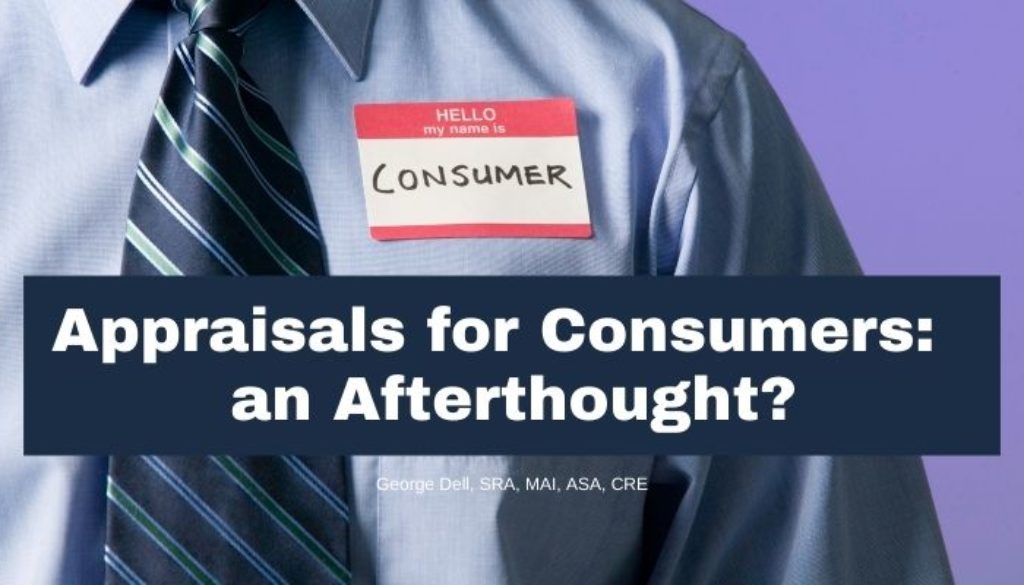Consumer home loan valuations serve those who pay the bill – the lender. This cost is passed on to the buyer, and the buyer usually has a right to get a ‘copy’ of the report. However, the valuation is not there to help the buyer decide whether the price is fair or a good investment. It is not there to help the consumer buyer decide on a purchase. It comes too late! The valuation does not help the home buyer be well informed as is required for the federal definition of value.
Our government-mandated definition of “market value” assumes that the homebuyer is well advised. It appears that today consumers are less well-advised than before. Why?
First, there is an explosion of use of free consumer-facing “automated valuation models.”
Second, the pandemic reduces buyers’ home visits and personal contact with real estate agents. (Sellers also want fewer unmasked looky-loos in their homes.)
Third, lender reliance on the automated models has continued to increase. AVMs (Automated Valuation Models) are not appraisals. An AVM does not perform an inspection of the house. An AVM does not know the interior condition, additions, code violations, hazardous contamination, and termites, as well as any positives, like new plumbing, electrical, or kitchen remodel.
So, what’s the problem? Each of the above increases the variation of reported “value.” Of course, there are disclaimers of value, using substitute terms such as ‘estimate’ or other proprietary label. These are not appraisals. No.
So, what do we know about any tests of reliability?
Each vendor, each AVM, provides a different number, or range of numbers. Most often this label of uncertainty is called an FSD (forecast standard deviation). Each AVM product provides this. Unfortunately, this FSD (or “confidence score” calculation) is also a secret. A proprietary secret.
Can we say the consumer is “well informed or well advised” in a home purchase decision? It appears not.
So what is the problem? AVMs (and appraisers) must value to the going market price value, as set by buyers who are not well informed nor well advised. AVMs (as well as appraisers) set their ‘estimate’ or ‘opinion’ by this price level, which can be inflated. In the past, the ‘market’ ignoring the critical parts of the very definition of market value has caused inflated market prices, which then become the official “market value.”
Several solutions have been proposed. A quick list:
- AVMs and appraisals may need to focus on actual competitive markets, rather than larger areas or anecdotal ‘comp’ sales.
- Value based on fundamental relationships of all goods and services, in place of comp prices.
- Forecasting of value risk into the near future, say 90 days, one year, or three years.
- A rigorous adherence to the very definition of market value that we already have.
The loan industry and the valuation function are allegedly for the ‘public good.’ Is today’s home consumer somehow not part of the public trust . . . ?

October 14, 2020 @ 6:41 am
Great article!
October 17, 2020 @ 4:32 am
George, great piece, as usual. I have some data and (anecdotal) evidence of the percentage of buyers who are not well informed and how pervasive the problem is regardless of up or down markets. And, if you want to make some new friends, when performing an appraisal that ends up lower than the contract price, indicate in the analysis of the current agreement that “the buyer does not appear to be well informed or well advised”. Your phone will ring, I assure you.
December 7, 2020 @ 1:06 pm
Thank you Bill,
I would love to see what you have on informed buyers.
Of course, informed buyers might slow down sales and commissions!
Can’t have that!
December 8, 2020 @ 5:40 am
Hi, I don’t really understand this piece. Are you recommending that consumers look into obtaining an appraisal or an AVM? Or just that they continue purchasing as is? Sorry, but not really clear to me, and I am definitely not the sharpest tack in the box, so could just be me.
What has really gone by the wayside is the analysis that is driven related to current market competition, after all, buyers are not basing their prices on what sold three months ago, but what their current options are. Or what about truly looking into the trends in the immediate competitive segment as well as the city/county, etc, and what some of the looming issues could be (think forbearance, evictions, coupled with lack of supply, and on and on)?
A qualified and diligent appraiser can measure what is going on better than an AVM, but the problem for consumers is wading through a bunch of online data to get to the appraiser who can help them understand value and make an informed decision. I still very much am pro, local professional appraiser who analyzes the market.
Hope you are well George, and hope this is not too controversial, but I am a bit befuddled by this post.
January 8, 2021 @ 8:32 am
That’s awesome! *stealing* going to have to try this… LOL jk 😉 but seriously folks, this is the crux of the problem today
August 1, 2021 @ 11:32 am
Thank you!
I was really asking the question, not recommending either way, and pointing out the questions that need to be considered to get closer to this answer.